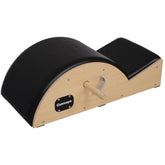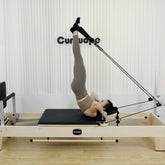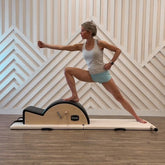Using the Pilates Reformer for Spinal Correction
Maintaining proper spinal alignment is essential for overall health, affecting posture, mobility, and quality of life. However, modern lifestyles, characterized by prolonged sitting, poor posture, and limited physical activity, can lead to spinal misalignment and associated issues such as chronic pain and reduced mobility. Fortunately, Pilates, particularly through the use of a Pilates Reformer, offers an effective solution for spinal correction. This blog explores the importance of spinal alignment, the role of Pilates Reformers in core strength training, recommends specific Pilates exercises beneficial for spinal correction, and concludes with the proven efficacy of Reformers in restoring natural spinal positioning.

Introduction: Importance of Spinal Correction
Proper spinal alignment ensures balanced muscle engagement, efficient movement, and minimal strain on ligaments, tendons, and joints. Conversely, spinal misalignment can cause uneven pressure distribution, leading to pain, stiffness, and increased risk of injury. Chronic misalignment contributes to long-term musculoskeletal issues, decreased flexibility, and impaired overall health.
Given the prevalence of sedentary lifestyles and repetitive stress on the spine, proactive spinal correction becomes essential. Addressing alignment through targeted exercises promotes long-term health benefits, including pain reduction, improved posture, increased energy, and enhanced overall mobility.
Pilates Reformer and Spinal Correction: Core Strength Training
Pilates Reformers provide a uniquely effective method for spinal correction, emphasizing core strength, balanced muscle development, and enhanced flexibility. Designed with a sliding carriage, adjustable spring resistance, and multiple accessories, Reformers facilitate precise, controlled exercises targeting deep stabilizing muscles critical for spinal alignment.
Core muscles, including the transverse abdominis, multifidus, and pelvic floor, provide essential support for the spine. Pilates exercises on the Reformer focus explicitly on strengthening these muscles, creating a stable and supportive muscular corset around the spine. This stability significantly reduces pressure on the vertebrae and discs, promoting proper spinal alignment and reducing the risk of misalignment-related injuries.
Recommended Exercises: Pilates Movements for Spinal Correction
The following Pilates Reformer exercises are highly effective for spinal correction:
Footwork Series
A foundational exercise that strengthens core muscles and improves leg and hip alignment. This series supports the spine's natural curvature and enhances overall stability.
Short Spine Stretch
This exercise focuses on spinal articulation and flexibility. By gently rolling the spine upward and downward, it decompresses the vertebrae, promoting flexibility and improved alignment.
Swan Dive
Ideal for strengthening the back muscles, the Swan Dive promotes spinal extension, counteracting forward-leaning postures commonly adopted during prolonged sitting.
Mermaid Stretch
Enhances lateral flexibility and corrects side-to-side spinal imbalances, contributing significantly to overall spinal alignment.
Pulling Straps
Strengthens the upper back and shoulders, crucial for correcting rounded shoulder postures. Regular practice helps realign the upper spine and improves posture.
Elephant
A classic Pilates movement that targets hamstring flexibility and core strength, promoting spinal elongation and reducing lower back stress.
By regularly incorporating these exercises into a Pilates Reformer routine, individuals can significantly improve their spinal alignment, posture, and overall musculoskeletal health.
Case Studies: Real-life Success Stories
Case 1: Jessica, Office Worker
Jessica suffered chronic lower back pain and poor posture due to prolonged sitting. After practicing Pilates Reformer exercises consistently, she noted substantial improvements. “My posture dramatically improved, and the constant pain I experienced significantly reduced. Pilates exercises strengthened my core, supporting my spine more effectively,” Jessica reported.
Case 2: Thomas, Athlete
Thomas, a regular runner, faced spinal misalignment issues and recurring injuries. He integrated Pilates Reformer sessions into his training regime, resulting in noticeable benefits. “Pilates helped me correct muscular imbalances and improve spinal alignment. My injuries reduced significantly, and I experienced greater mobility and stability during runs,” Thomas shared.
Conclusion: The Effectiveness of Pilates Reformers in Spinal Alignment
Regular Pilates practice using the Reformer has demonstrated consistent effectiveness in correcting spinal alignment, enhancing core strength, and improving flexibility. By specifically targeting the deep stabilizing muscles, Pilates exercises restore and maintain the spine's natural alignment, significantly reducing chronic pain and discomfort.
Whether addressing existing spinal alignment issues or proactively preventing them, Pilates Reformers provide a comprehensive, sustainable solution. Through targeted, controlled movements, users experience enhanced posture, improved flexibility, increased strength, and reduced risk of injury.
Ultimately, the Pilates Reformer stands out as a highly effective tool for anyone seeking to achieve and maintain optimal spinal alignment, promoting long-term musculoskeletal health and overall well-being.





